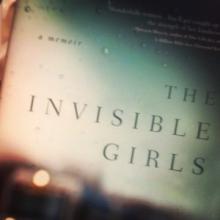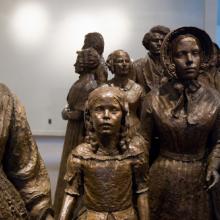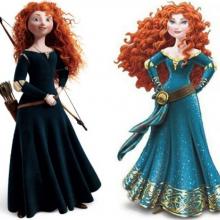Women and Girls
It’s a hard truth that, in the real world, Goliath sometimes beats David.
In the July issue of Sojourners, I wrote about the battle to save the Anna Louise Inn and how Cincinnati’s faith community has come together for the fight. Run by Cincinnati Union Bethel, a small non-profit, the Inn has provided safe and affordable housing for women in the city for 104 years and is one of Cincinnati’s most revered institutions.
But last Monday, Cincinnati Union Bethel announced it was selling the Anna Louise Inn to Western and & Southern Financial Group after a two-year legal battle.
“The needed resources, time and energy to this litigation has diverted focus from our other successful programs,” they wrote on their website. “This settlement and purchase agreement allow us to dedicate ourselves to our mission of serving women and children.”
Cincinnati Union Bethel owns both the Inn and the land on which it sits, but Western & Southern – a Fortune 500 company located across the street – wanted the property to build high-end real estate. So, when Cincinnati Union Bethel received $13 million in federal tax credits to renovate the Inn, Western & Southern sued them and the city of Cincinnati.
I first became aware of the realities of sexual abuse in the church at the tender age of five. I happened to look at the television screen and witnessed police officers escorting my hand-cuffed youth minister in front of a crowd of reporters screaming questions. The words “YOUTH PASTOR ABUSED CHILDREN” flashed across the television screen.
I was confused and scared. My family comforted and assured me that the pastor had only “hurt” teenage boys and that I was safe. The church hired a new minister and, on the surface, life seemed to resume to normal for our congregation. But as a child I had no idea of the effects of the abuse and its aftermath had on the survivors, their families, and our church community. Many families soon experienced disintegrating marriages, friendships were broken, and faith was lost. One survivor’s family had their home repeatedly vandalized and were forced to move hundreds of miles from our town to escape fellow believers who grew angry with them for filing a lawsuit against the perpetrator.
Church leaders shunned media attention and feared “airing dirty laundry” in public, encouraging members to keep the experience a secret for the sake of the boys and church. As a child, and then a teenager, growing up in an otherwise loving, connected church, I never remember hearing church leaders address this aspect of our shared history in the open. To some of the survivors and the broken-hearted, the silence on this topic was welcome; to others it was deafening. While secrecy was the rule, the legacy of the abuse was real and active in the community. Rather than being cared for with dignity and love, the survivors and their families felt that they were a shameful secret to be whispered about and hidden. I learned as an adult that I was intimately connected with some of the survivors but never knew about their silent pain. I had no idea that I was a participant in a culture of silence and shame that often surrounds sexual abuse and is especially pronounced when boys are abused by men in the church.
A group of priests and nuns, some of whom were assaulted as children, has quietly been gathering to publically urge the pope and American bishops to "clean house" on sexual abuse in the church.
Many members in the group, though vocal on sexual abuse cases in the past, did not know eachother until last year, when a laywoman brought them together for as a "confidential support group."
The New York Times reports:
Their aim, they say, is to support both victims and fellow whistle-blowers, and identify shortcomings in church policies. They hope to help not just minors, but also adults who fall prey to clergy who exploit their power for sex. They say that their motivation is to make the church better and safer, and to show the world that there are good priests and nuns in the church.
“We’ve dedicated our lives to the church,” the Rev. John Bambrick, a priest in the Diocese of Trenton, said at a meeting of the group last week in New York. “Having sex offenders in ministry is damaging to our ministry.”&nbsminp;
Read more here.
Sarah Thebarge is the author of The Invisible Girls, a new memoir from Jericho Books. I was fortunate to get a few minutes to ask her a few questions about her touching, funny, compelling new piece of work.
Q: Your book is about Somali Refugees and also about your survival of breast cancer. How do you write one book about both things?
A: When I met the Somali mom and her girls on the MAX the first time, we had a lot of differences – different religions, ethnicities, skin color, and language. But as I developed a relationship with them, I realized that we had a lot in common at the core. Because I’d been a little girl growing up in a fundamentalist culture, where men buried you under yards of fabric and lists of rules and taught you that women were supposed to be silent. And I knew what it was like to be a refugee of sorts, because after I nearly died of cancer in my 20s, I sold everything I had and got on a plane with a suitcase of clothes and flew from the east coast to Portland, Ore., and started over. And so even though the narrative lines of the Somali refugee family and my cancer experiences seem disparate, they actually weave together well, because all this time, I’d been an Invisible Girl, too.
Consider in the past year alone, America has wrestled over the injustice of forced vaginal probe ultrasounds. We have had our own deep cultural apathy revealed as the media tipped their sympathies toward the jocks that ripped a 16 year-old girl’s life and body through gang rape in Steubenville, Ohio – even as our nation gasped in horror at multiple reports of gang rapes of women in India. And over the past few weeks we have witnessed the unmasking of several U.S. military leaders, who were charged with duties to protect the women in their ranks, as they were revealed to be the very perpetrators themselves.
In Jim Wallis’ latest column, he writes, “It’s time for all people of faith to be outraged” and adds, “And it's time for us in the faith community to acknowledge our complicity in a culture that too often not only remains silent, but also can propagate a false theology of power and dominance.”
Will we do it? Will we take the step? Will we allow this holy wind that has blown the cover off of evil deeds done in the dark to rush through? Will we allow the cleansing waters of God to wash our society clean of practices — both private and public — that twist, maim and crush the image of God in more than half its population? Will we exercise the same courage that it took for those women at the first Pentecost to allow the spirit to move them into the public square and speak — testify, tell the truth, and prophesy? Will we repent from our silence?
Repentance begins in the heart. So, I must ask: “Will I repent of my silence — my safe silence?” Yes.
On April 5-12, the University of Tennessee hosted “Sex Week,” organized by the student organization Sexual Empowerment and Awareness in Tennessee. The week’s activities, ranging from discussions on virginity to workshops on oral sex and a search for a golden condom, sparked the concern of easily provoked and immensely quotable State Rep. Stacey Campfield (he of “Don’t Say Gay” bill fame).
With apologies to Campfield’s ever-vigilant protection of Christian sensibilities, the real problem here is not that mandatory student fees are being used to promote sexual education and awareness. The problem is that our tithes aren’t.
Imagine with me, if you will, what would happen if “Sex Week” came to First Baptist Church . . .
If local congregations joined together to dedicate a week to the promotion and exploration of Christian ethics expressed through sexuality, gender, and embodiment, what might the offerings look like? Perhaps these would be a good start.
When Angelina went public with her decision to have a mastectomy, what she called “My Medical Choice,” we couldn’t stop relating to her as a source of identity. Everyone is taking sides, as is our custom. Whether we applaud or condemn her decision, either way we are not seriously discussing the issue. Because when it comes to Angelina the celebrity, our major issue is always getting an identity boost from her. It was probably a bit naïve for her to think that we would react in any other way. She is not our friend, after all, not a “person” in any real sense. She is a “personage,” a distant but tantalizing figure who captures our imagination and invades our identities.
Many people are wondering if Angelina did the right thing. I’ve been asked it a few times in the last 24 hours and my family and friends know I don’t traffic in celebrity gossip very often! Yet they want to know what I think, and because I have not been either an Angelina fan or a hater, my reaction is subdued. I have nothing to win or lose by praising her or by trashing her, for that matter. I don’t feel scandalized or in a position to judge. She made a personal decision and because she’s a personage she went public with it; it’s as simple as that.
Having a 3-year-old daughter opens your eyes to a world that you did not know existed, the world of princesses. Disney has cornered the princess market; there are currently 11 official Disney princesses, and if you are brave enough to travel to Disney World/Land or even a Disney store, you will soon find out that there is a plethora of accessories — dresses, placemats, and cups (just to name a few).
Disney has come under fire in the past for focusing only on Caucasian women — Snow White, Cinderella, Aurora (Sleeping Beauty) and others. But over time, non-white princesses were introduced, like Mulan, Pocahontas, Jasmine, and Tiana.
Disney’s latest princess was Merida from the film Brave broke most of the Disney princess rules. She didn’t like pretty gowns, she liked to shoot bows and arrows, and her crowning glory was frizzy, wild red hair. Some people believed that Disney had finally broken the mold of the “damsel in distress” model of princesses that has been a dominant theme throughout many of the films. The trend actually started with Pocahontas and Mulan; maybe the theme of strong women role models would continue. Brave was a cute film with a wonderful message. Merida had a round face and was rough and tumble with her triplet brothers. She didn’t want fancy dresses or even want to be a princess; Merida just wanted to be Merida. She was the example of girls being girls, no matter how they look.
However, in a recent update, Disney decided to take the idea of Merida in Brave and throw it out the window. Merida, for her official induction into the Disney princess cohort, got a bit of a makeover. Merida 2.0 was taller, skinnier in the waist and had a slimmer face. Her famous bow-and-arrow set are missing, and her iconic wild hair has been tamed.
After the uproar that followed, Disney quietly pulled the newer version of Merida.
But my question for Disney stands: why? What was so wrong with Merida that it warranted the change?
I hate Abercrombie & Fitch.
It all started a few years ago. A member of my youth group worked at one of their stores in a Chicago suburb. I was minorly troubled that she was employed at the store. But what really flamed my loathing for Abercrombie was when they asked her to model their clothes for their catalogue. She told me about their offer and I responded in the only way an over-protective youth pastor could:
“NO! Absolutely not! No way in Hell are you doing that!!!”
I don’t think that Abercrombie is evil per se. I only hate them because they stand for everything that I’m against!
Over the weekend, BusinessInsider.com published an article titled “Abercrombie & Fitch Refuses to Make Clothes for Large Women.” The article included a comment made by Abercrombie CEO Mike Jeffries in 2006. He described his business strategy by stating:
In every school there are the cool and popular kids, and then there are the not-so-cool kids. Candidly, we go after the cool kids. We go after the attractive all-American kid with a great attitude and a lot of friends. A lot of people don’t belong [in our clothes], and they can’t belong. Are we exclusionary? Absolutely. Those companies that are in trouble are trying to target everybody: young, old, fat, skinny.
Violence against women is the most prevalent and the most hidden injustice in our world today. From rape as a weapon of war, to human trafficking, to the attack of a young girl seeking an education, the treatment of women and girls across the globe is in a state of crisis.
And we don't even need to leave our own shores to encounter staggering statistics. Here in the U.S., 1 in 5 women have been raped in their lifetime — a number that only jumps when you realize that 54 percent of sexual assaults are never reported. More than 1 in 3 women have experienced some kind of intimate partner violence. Sexual assaults in the U.S. military continue to rise — with an estimated 26,000 in 2012 alone — even as its leaders claim to be addressing the epidemic.
As I lay out in my book On God’s Side, what has been missing from this narrative is the condemnation of these behaviors from other men, especially men in positions of power, authority, and influence — like those in our pulpits. In a section of that book, I say we need to establish a firm principle: the abuse of women by men will no longer be tolerated by other men. The voices of more men need to join the chorus to make that perfectly clear.
It's time for all people of faith to be outraged.
Most of us are too familiar with this story: an Upper Midwestern Baptist minister claims that “God made Christianity to have a masculine feel [and] ordained for the church a masculine ministry.” Or a Reformed Christian pastor mocks the appointment of the first female head of the Episcopal Church, comparing her to a “fluffy baby bunny rabbit.” Or a Southern Baptist megachurch pastor in California says physical abuse by one’s spouse is not a reason for divorce. Or numerous young evangelical ministers brag about their hot wives in tight leather pants.
Fewer of us are familiar with this story: Tamar is raped by her half-brother Amnon. Tamar protests her brother’s advances, citing the social code of Israel, his reputation, and her shame, to no avail. Their brother Absalom commands her to keep quiet, and their father, the great King David, turns a blind eye.
What do these contemporary statements above, delivered into cultural megaphones with conviction and certainty, have to do with the Old Testament rape and silencing of Tamar? The difficult answer is, quite a lot. The narrative dominance of these stories rests on power and control, which — whether intentional or not — speaks volumes about whom the church serves and what the church values.
Resources to help you raise awareness about—and liberate—the slaves among us.
The Anna Louise Inn first opened in 1909. Built on the Taft family’s front yard, the Inn provided safe and affordable housing for women in Cincinnati. Since then, the Inn has become a revered Cincinnati institution. Click on the gallery below to view some images of the Inn’s history.
On Tuesday, Angelina Jolie became the face of preventative mastectomy. In a beautifully worded New York Times op-ed, the actress said she opted for a double mastectomy after learning she had an 87 percent risk of breast cancer, adding, “On a personal note, I do not feel any less of a woman. I feel empowered that I made a strong choice that in no way diminishes my femininity.”
In the hours following the publication of Jolie’s story, others came forward with their own stories, and the media coverage since has been non-stop. However, when a similarly famous actress, Catherine Zeta Jones, came forward with her diagnosis of bipolar II disorder, it made only a news ripple compared to the crashing wave of coverage Jolie’s disclosure has received. Don’t get me wrong — Jolie’s announcement is hugely significant and part of a much-needed conversation. But mental illness should be afforded the same level of discourse. Perhaps talking about mental illness isn’t as fascinating as talking about an actress’s decision about her breasts, but talk about it we must — and unfortunately not even a courageous disclosure made by a beautiful and famous actress like Catherine Zeta Jones is enough to get that conversation started.
Every family involved, every neighbor, even those of us who look on in horror, will be forever stained by this horrific, sustained act. If any human act warrants eternal punishment, this clearly does. As much as I consider the death penalty barbaric, in this case death seems far too merciful. The perpetrator will never breathe a single breath free of shame and disgrace. The sin, by any standard, is beyond the pale. The case makes me wonder what judgement, punishment, and mercy might even mean. And like everyone else, my first impulse is to put as much distance as I can between this ‘sin’ and my own.
But we lie to ourselves if we imagine that our sin is no less ugly in the eyes of God. Is my, or your sin, really so different?
REV. SUSAN QUINN BRYAN walked into a meeting of the Friends of the Anna Louise Inn fully prepared for a room brimming with people. Instead, Bryan and the five other Presbyterian pastors she had brought with her doubled the meeting’s total attendance. Bryan was stupefied.
When she moved to Cincinnati in 2005 to pastor Mount Auburn Presbyterian Church, several of her congregants had taken her to the Anna Louise Inn, claiming it as one of the things they loved most about the city. And yet, in its time of need, hardly anyone had come to the Inn’s rescue. It would take several minutes before an even more startling realization came to Bryan.
“As [people] began talking, I thought, ‘Where’s the church? How can the church stand silent while this is happening?’” she said. “So I organized a breakfast and just sent out emails to all the clergy I could find.”
About 25 Cincinnati faith leaders came to Bryan’s breakfast, and out of it emerged an ecumenical force, crossing denominational divides to rally behind one of Cincinnati’s most revered institutions.
THE BATTLE FOR the Anna Louise Inn began in 2007 after Cincinnati Union Bethel (CUB), the social service agency that operates the Inn, decided the Inn needed updated facilities.
“HAVE YOU BEEN born again?” The image of a second birth to illustrate conversion is often used by fundamentalist and conservative evangelical Christians. Yet in my experience such folks also tend to resist thinking of God as other than male. How can they overlook this very maternal activity of God’s Spirit?
Even Nicodemus gets it, at least at the physical level. In John 3, this high-ranking Jewish leader privately approaches Jesus to ask him where his charism comes from. In most familiar translations of the New Testament (such as King James and NIV), Jesus tells Nicodemus that he would understand if he were “born again” (3:3). But the Greek word anōthen is deliberately ambiguous. Jesus’ intended meaning is “born from above” (NRSV). “That which is born of the Spirit is spirit,” says Jesus in verse 6. The Holy One is our birthing mother.
When the literal-minded Nicodemus asks how a person can go back into his mother’s womb and be born again, we cannot be sure (in 3:9-10) whether Jesus gently chides or sarcastically puts him down: “Are you a teacher of Israel, and yet you do not understand these things?”
Sadly, many “teachers” throughout Christian history have not understood these things. It is now 50 years since Betty Friedan’s The Feminine Mystique opened the floodgates of second-wave feminist cultural analysis, thus preparing the ground for biblical scholars and theologians such as Letty Russell, Rosemary Radford Ruether, Elizabeth Schüssler Fiorenza, and many more. Some of us began to see that orthodox, “objective” methods of interpretation were instead often subjectively male-oriented. We began to ask, “Where is the feminine in our sacred texts? Were women there?”
I see five ways in which the gospel of John deconstructs, or at least unsettles, the rigid patterns of patriarchy in the family and society in which Jesus lived. The roles Jesus played during his life and ministry were so atypical that they color this entire narrative.
MARTA AND LUISA had always fantasized about leaving their small town in northern Mexico to become dancers in a big city.
As the teenage sisters sat in the bed of a rusted pickup truck speeding toward the U.S. border, they thought their dreams would soon become reality. After sunset, the truck screeched to an abrupt stop. A middle-aged man with a skeleton tattoo on his arm hopped out of the driver’s seat, gritted his yellow teeth, and mumbled, “Vamos.” The time had come to complete the journey by foot.
Marta and Luisa walked closely behind the man and his two associates for hours along the desert paths they believed led to a brighter future. When they crossed the border into Arizona at about midnight, the tattooed man forcefully grabbed 16-year-old Marta and separated her from her older sister.
He explained that although he previously offered to help the girls cross the border for a small fee, the transportation cost had risen. Now Marta would have to work to pay off her debt. Alone.
Cecilia Hilton Gomez, director of Hispanic outreach programs for Free for Life International, describes the way that many human traffickers prey on vulnerable girls hoping to emigrate to the United States from Mexico and other parts of Central America. Since girls like Marta often have little education, lack formal paperwork, and have no knowledge of English, they become prime targets for traffickers looking to profit by selling women to brothel owners in the U.S.
“This is an epidemic, and it’s increasing,” Gomez states. “A lot of people think slavery has been gone for years, but it’s one of the largest criminal enterprises that exists now, and it’s right here in America.”
Moms should be celebrated, and they deserve all the flowers, spa days, pampering, and gifts given to them. I love my mom and I can’t thank her enough for all she has done for me and my family — Mother’s Day doesn’t even begin to cover the gratitude I have for her.
But for many, Mother’s Day is the most painful day of the year. For women who have experienced miscarriages, have had children die, have had abortions, who want to have kids but are struggling or unable to, have had to give up their children or currently have broken relationships with their kids, the holiday serves as a stark reminder filled with personal sorrow.
Christian communities can be especially harsh because of their tendencies to show favoritism to the idea of motherhood — as if mothers are somehow more holy and righteous than non-mothers. In an effort to praise and empower marriage, healthy parenting, families, and the sanctity of life, Christian subculture often mistakenly and unintentionally alienates those around us — especially women.












